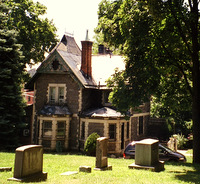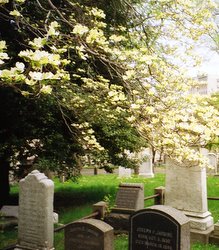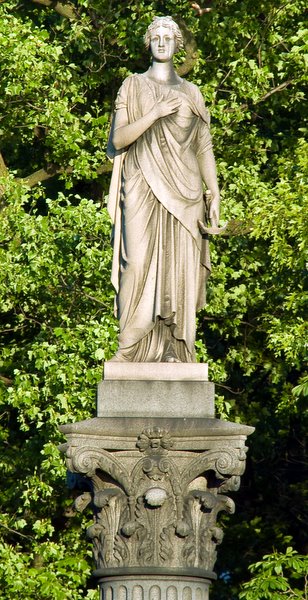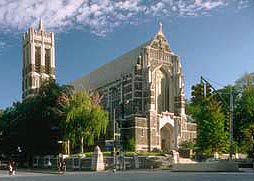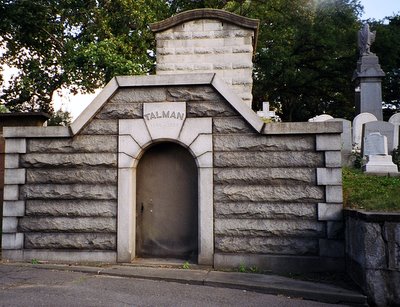The price of private burial and vault plots, of the size of fifteen feet square, in all the grounds between the Tenth and Twelfth Avenues (excepting those on the mound near 10th Avenue) is $65 – and for lots of a larger or smaller size the price is in proportion. The price of plots in the mound is $90 per lot fifteen feet square, and in proportion for lots of a larger or smaller size. Children’s graves $2 each; adults, single graves $5. A chaplain resides near the cemetery whose duty it is to read the Church funeral service at the place of sepulture when requested. When this private service is desired, previous notice must be given. Keeper and Superintendent: William Dunlop.
Rode's City Directory
1854-1855, p. 125
A (Virtual) Walk through Trinity Cemetery
(Click on any image for a larger view.)
Eastern Portion
Western Portion
Jerry Orbach
Ralph Waldo Ellison
A Bit of the Cemetery's History
By the mid-19th Century, the cemetery surrounding Trinity Church Wall Street was reaching capacity, forcing the Trinity Corporation to look for alternative burial grounds. After weighing various options – among them subscribing to a large parcel in Brooklyn’s Green-Wood Cemetery or buying acreage Morrisania (the western part of the Bronx) – the corporation settled on twenty-three acres that stretched from 153rd Street to 155th Street and from 10th Avenue (present-day Amsterdam) to the North River (as the Hudson was then known in northern Manhattan)
Richard F. Carman, who owned the parcel, had begun his working life as a box-maker, but in the wake of the Great Fire of 1835, had realized the opportunity for expansion and moved quickly into real-estate speculation and finance (sitting on boards of both banks and insurance companies). His real estate dealings in northern Manhattan began around 1836 and almost immediately suffered a setback when he and James Conner, an innovative printer who earned fame for his stereotype edition of the Bible for the American Bible Society, formed a partnership and speculated on the Watkins farm, eighty-six acres lying north of 151st Street. They apparently knew that the Board of Aldermen was looking for land to use as a rural cemetery and purchased the land to offer the Aldermen for that purpose, but after a year’s deliberation, the Aldermen chose an alternate site, leaving Carman and Conner with heavily mortgaged property that they soon lost in a foreclosure action. Carman began acquiring land again and on October 1, 1841, repurchased twenty-nine acres of the Watkins farm from The New York Bowery Fire Insurance Company – the same day the Audubons bought an adjacent fourteen acres that would become Minnie’s Land. Carman added part of his purchase to Carmansville, the working-class village he was developing in lower Washington Height, and a year later, sold twenty-three (and 94/100) acres Trinity Corporation for the rural cemetery he and Conner had envisioned several years before.
As soon as Trinity Corporation closed the sale, it hired James Renwick, Jr. to design paths and drives and to landscape the cemetery, which quickly became a recreational destination as well as a home for the dead; the park-like setting drawing Manhattanites up town. Several decades later, when the city extended the Boulevard (Broadway) to 155th Street, bisecting the cemetery, Trinity Corporation hired Calvert Vaux to design a bridge to connect the east and west parts and at the same time, to re-landscape the cemetery.
From Trinity Cemetery's earliest days, guidebooks, magazines, and newspapers paired it with Minnie’s Land and Audubon Park as places of interest to see in northern Manhattan. In an early example, the illustrated travelogue, The Hudson: from the Wilderness to the Sea, Benjamin J. Lossing blends a description of Trinity Cemetery into his longer one of Minnie’s Land (this excerpt is the last portion of the two page description of Minnie's Land and Audubon).
Audubon died at the beginning of 1851, at the age of seventy-one years. His body was laid in a modest tomb in the beautiful Trinity Cemetery near his dwelling. This burial-place, deeply shaded by original forest trees and varieties that have been planted, affords a most delightful retreat on a warm summer’s day. It lies upon the slopes of the river bank. Foot-paths and carriage-roads wind through it in all directions, and pleasant glimpses of the Hudson may be caught through vistas at many points. In the south-western extremity of the grounds, upon a plan granite doorway to a vault, may be seen, in raised letters, the name of Audubon.
In the late 1880s, the city signaled its intentions to pave and grade 153rd Street, prior to officially opening it, Audubon's tomb stood directly in the path, so the Trinity Corporation offered the Audubon family a new plot in the eastern section, close to Broadway and within sight of Audubon Park.
Throughout the 19th and 20th Centuries, Trinity Cemetery accepted the dead for burial. When land was no longer available, in the later 20th Century, the Trinity Corporation developed the Mausoleum, an above-ground series of structures in the far south-west corner of the cemetery grounds, so Trinity Cemetery continues to inter the dead, the only place in Manhattan that does so (legitimately). The Masoleum has accommodated New Yorkers such as Jerry Orbach and Ralph Ellison and, as announced in March 2009, will be the final resting place of former Mayor Ed Koch.
Highlights of your visit to Trinity Cemetery (this is only a sampling of the many historic graves and interesting markers in the cemetery. For more information, see the links at the bottom of the page.)
Church of the Intercession First Building (return to top of page)
Begin your visit in the Eastern half of the cemetery, at the Amsterdam Avenue gates directly across the street from the original site of the Church of the Intercession. The Trinity Corporation's original plans for the cemetery included construction of a church within it's bounds and allocated $4500 for the church and another $500 for an organ, but local residents – including the Audubons, Carmans, Richard Morewood, Hickson Field, James Monroe (nephew of the President), and Montaignie Ward – preempted those plans when the Rev. Stephen Douglas of St. Andrew's Church down the hill in Harlem began holding divine service in Carmansville, in a room in a building Richard Carman owned. In December 1847, the Church of the Intercession incorporated and chose Richard M. Abercrombie of St. Andrew's as its first rector. The following May, Carman sold "The Rector, Church Wardens, and Vestrymen" two lots on the north-east corner of 10th (Amsterdam Avenue) and 154th Street for $1.00, with the stipulation that the property would only be used in perpetuity "for a Church, Chapel, or Parsonage to be erected thereon." The elder Audubon son, Victor was Vestry secretary as well as a member of the building committee and John Woodhouse, his younger brother, was one of the builders.
Intercession drew parishioners from all over Washington Heights, but throughout its early life, it depended upon a yearly contribution from the Trinity Corporation, in exchange for which, Intercession could "be used for funerals at the cemetery and its Rector officiate at them when requested, also in the cemetery at burials." This somewhat curtailed the Rev. Abercrombie's income, as funeral fees were normally additional to a rector's salary. Presumably, the Vestry added the $100 to the Rector's salary and not to the general operating expenses of the church. (Click here for for more information about the second church building and here for information about the third, which is standing in the cemetery today.)
Eastern Portion
Caretaker's cottage (return to top of page)
In the far south-eastern corner of Trinity Cemetery (at your left when you are standing at the gates looking into the cemetery) is the caretaker's cottage. Before the cemetery opened, the Trinity Corporation provided a cottage for the caretaker and appointed William Dunlop to the position, though he probably inhabited a house that was predecessor to this building.
The Mound and Revolutionary War Marker (return to top of page)
The purchase price for a lot on the mound has always been higher in Trinity Cemetery, perhaps because of the expansive vistas it once would have afforded of pre-apartment building Washington Heights or perhaps because of the historic associations with the Battle of Harlem Heights in 1776, when this mound formed part of the first line of defense. A marker on the mound commemorates the Revolutionary War battle and here, you can see one of several flowering dogwood trees in the cemetery. (Another Revolutionary War marker is set in the wall of the western side of the cemetery, on Broadway, near 153rd Street.)
Fernando Wood (return to top of page)
Across from "The Mound" approximately halfway between the Amsterdam gates and the church, is a memorial to Fernando Wood, Mayor of New York City from 1854 to 1858 and New York Congressman from 1863 to 1865 and 1867 to 1881. During the Civil War, Wood, who was not sympathetic to the Northern cause, attempted to have New York City declared a "free city" so that it could trade with the South, a plan that (impractical though it might be for survival of the Union) might have alleviated some of the Audubon's financial worries, which were exaccerbated by uncollected subscriptions in southern states. More on Fernando Wood.
Audubon Monument (return to top of page)
Directly behind the church, and facing the gates on 155th Street is the Audubon Monument. Stand in front of the monument, face the gates and imagine a broad vista opening in front of you. That's what you would be seeing if the 1893 plan to extend Audubon Avenue to 155th had occured. However, as with many public projects, this one fell prey to budget woes following the New York City Consolidation in 1897. The new burroughs, particularly Brooklyn, put demands on city funds that pushed other projects to the waiting list, or cancelled them entirely. Nowhere was this more evident than Washington Heights. Nine miles from City Hall and less developed than Brooklyn, Washington Heights seemed easier to stall. For more about the Audubon Monument, click here.
Gothic Suspension Bridge (erected 1872 and dismantled in 1911) (return to top of page)
The idea of a Gothic Suspension Bridge crossing Broadway and connecting the two sides of the cemetery is tantalizing and raises questions such as whether it was a favorite hide-and-go-seek place for children (or were they forbidden to play in the cemetery), did it creak when people walked across it, and how many young men stole a first kiss there?
Western Portion
Tyng Memorial (return to top of page)
Inscriptions on the Tyng Memorial that dominates the western half of the cemetery tells the romantic story of Stephen H Tyng, Jr. who was lost at sea on May 1, 1918 when the ship carrying him to training to fight in WWI, which was coming to an end and his widow. According to a newspaper report, Tyng had been married in the afternoon before he boarded the ship. Buried beneath a simple marker near the base of this grand monument that is topped by a draped figure holding an anchor in her left hand, is Elizabeth Wakefield Tyng, widow of Stephen H. Tyng who outlived her husband by almost fifty years, but never remarried.
Clement Clarke Moore (return to top of page)
Though best known today for his poem, "A Visit from St. Nick," (which some evidence suggests he did not even write), Moore was a noted theologian, as well as Latin and Greek scholar. Since 1911, the Congregation of the Church of the Intercession has honored Moore with a ceremony on the Sunday before Christmas. Moore's gravestone is near the cemetery's western wall.
Mausoleum (return to top of page)
Jerry Orbach
The actor Jerry Orbach is interred in the Mausoleum at the far south-western end of the cemetery, in the vicinity of the original Audubon tomb. Just a few blocks north are many of the shooting locations for Law and Order, in which Orbach was creating his last role, Dective lennie Briscoe, at the time of his death in 2004.
Ralph Waldo Ellison
Author and educator Ralph Waldo Ellison, who is best known for Invisible Man, but who wrote numerous short stories, essays and works literary criticism and also made his mark as a photographer, musician, and sculptor, was buried in the Trinity Mausoleum in 1994.
Astor Crypt (return to top of page)
On one of the lower tiers, close to the 155th Street side of the cemetery is the Astor crypt, which includes Caroline Schermerhorn Astor, the Mrs. Astor whose pretentions prompted formation of the "List of 400," John Jacob Astor III, grandson of the famiiy patriarch, and Madeline Astor, a Titanic survivor and widow of John Jacob Astor IV, who went down with the ship.
Talman Crypt (return to top of page)
Though Edward Talman was a bank teller and low-level banking official for all of his working career, in the early 1850s, when the Audubons were facing financial ruin, he and his wife Delia bought a small lot in Audubon Park, possibly as a loan to Victor Audubon, who re-bought the lot a year or so later. Delia, Edward Talman's wife, and Georgianna, Victor Aubudon's second wife, were sisters and after Victor's death, the Talmans lived in Audubon Park, as boarders in Georgianna's home. The Talmans are both buried in the Talman crypt high on one of the upper terraces in the west side of the cemetery.
Jumel Crypt (return to top of page)
One of the liveliest characters to inhabit Washington Heights was Eliza Jumel, who .married the wealthy Frenchman, Stephen Jumel, who then purchased the Morris mansion on Washington Heights (forfeited by Roger Morris when he sided with the British during the Revolution), where Eliza spent the remainder of her life. Within a year of becoming Jumel's widow, Eliza succumbed to the allure of Aaron Burr and married him, though they separated within weeks of the marriage, reportedly because the new Mrs. Burr found her husband coddling a chamber maid in the parlor. Madame Jumel intended to leave the bulk of her fortune to the Church of the Intercession, but her heirs contested the will and Intercession, rather than endure a long court trial, dropped claim to the money – which is sorely needed in 1873, when the Sheriff barred the congregation from using the newly-built church on 158th Street because of unpaid bills. Madame Jumel's crypt is on the hillside in the western half of the cemetery.
Alfred Tennyson Dickens (return to top of page)
In 1912, when Alfred Tennyson Dickens, son of Charles Dickens and godson of the poet Alfred, Lord Tennyson, was on a lecture tour in the United States, honoring the centenary of his father’s birth, he suddenly died of a heart attack while staying at the Hotel Astor in Manhattan. With the consent of his family, he was buried in Trinity Cemetery in the corner closest to Broadway and 155th Street. In 1935, after two decades of plans and fund-raising, a stone was finally placed to mark the site of his grave.
Carman Monument (return to top of page)
Richard Carman,his wife, and sons are buried high on the western side of the cemetery, the gravesite overlooking land that he once owned and called Carmansville. The Carman monument was originally raised for Carman's daughter Lucene, who died in 1852.
Links to other Trinity Cemetery information (return to top of page)
Trinity Cemetery: mid 1800s
Caretaker's Cottage
Trinity Cemetery: Dogwood in bloom
 | ||||
Trinity Cemetery in the Summer
 | ||||
Tyng Memorial
Gothic Suspension Bridge
Just after Audubon bought his tract north of 155th Street, steps were taken which led to the establishment of one of the most beautiful and interesting cemeteries in the United States on the south side of that line.
About the year 1842, the Corporation of Trinity Church took up the matter of providing the parish with a "rural cemetery," and, after considering the proposition to have a large plot in Greenwood, and an offer from Mr. Gouverneur Morris of a plot at Morrisiana, finally purchased, on September 22, 1842, a piece of land in the Twelfth Ward, from Mr. Richard F. Carman, situated in what was then called the Village of Carmansville.
Annual Report By American Scenic and Historic Preservation Society
1913
Third location of the Church of the Intercession,
in Trinity Cemetery.
Audubon Monument
Carmansville, that part of the city on the west side between Manhattanville and Fort Washington, or between 135th and 160th sts. Audubon Park and Trinity Cemetery are here, and the Broadway and St. Nicholas Boulevard extend through it. The situation is high, and there are some fine residences and handsome grounds. It is accessible by the Hudson River Railroad branch from 30th st. depot to 152nd st., and by West Side Elevated Railway to 155th st.
Appletons' Dictionary of New York and Its Vicinity
1889
Talman Crypt
Birds Do Not Forget Him:
Beautiful Scene that is Enacted Daily Near Audubon's Grave
There is a little scene of rural nature enacted every evening up on Washington heights that probably cannot be seen in any other thickly settled part of New York, reports the Herald. Thousands of swallows, which make their homes in the big chimney of a church, gather from every direction about sunset and circle around over Trinity cemetery, retiring gradually to their nests. At daybreak they rise from the chimney in clouds and scatter to all points of the compass. Residents of the neighborhood regard these dally flights with affectionate interest. As I stood near the cemetery the other evening, watching the gathering hosts of birds circling against the pale light of the sky, I noticed a white haired old man leaning against a tree and gazing upward. From north and south, east and west, flocks of the graceful birds were arriving every moment to join the swirling multitudes. There were literally thousands of them, swooping in a wide circle over the silent graveyard and filling the air with plaintive cries. Suddenly the old man addressed me.
"What a beautiful sight that is," he said. "I have watched these flights for years. During the summer the birds come every evening about 6 o'clock and for an hour or more fly in that swift circle overhead before seeking rest."
"Why have they chosen this spot?" I asked.
"It has been their haunt for many years," said the old man. "I like to think it is, because their friend sleeps yonder. Can you see that monument?" He pointed with his stick through the massive iron fence that surrounds the cemetery. Through the gathering dusk I could make out a great white cross, on a high pedestal, glimmering in the twilight.
"That is in memory of Audubon," said the old man. "On one side of that cross are the sculptured forms of many birds."
"Just a block away is the old mansion where Audubon lived, now occupied by former Mayor Daniel F. Tiemann.
"Every evening in summer the swallows wing their swift way from Now Jersey, from Westchester and Long Island, and swing in that strange circle over the tomb of the naturalist and within sight of the place where he lived and worked. It seems as though It were a ceremony before a shrine."
Overhead the birds still swirled in a swift circle, and the darkening graveyard lay silent by for the soft rustling of the leaves. The sunset light faded. Suddenly one of the swallows widened the circle and a hundred swung out after him. The twittering cries grew fainter and stopped. The first detachment circled rapidly toward the chimney of the Church of St. Catherine of Genoa and dropped into it one by one. They had not all disappeared when another company swept out of the circle and disappeared. Rapidly the host grew less until finally the last of the birds had darted over and fluttered into the nests. The old man walked away slowly. All was darkness beyond the Iron gates, and silence.
Omaha Bee
(copied from the NY Herald)
September 23, 1898
Carman Family Monument
Walking Tours of Trinity Cemetery
Eric K. Washington: Afoot Walking Tours
ekwashington@gmail.com
Harlem is Home Tour: Trinity Cemetery
This way to return home . . .
Funded by the Audubon Park Alliance
